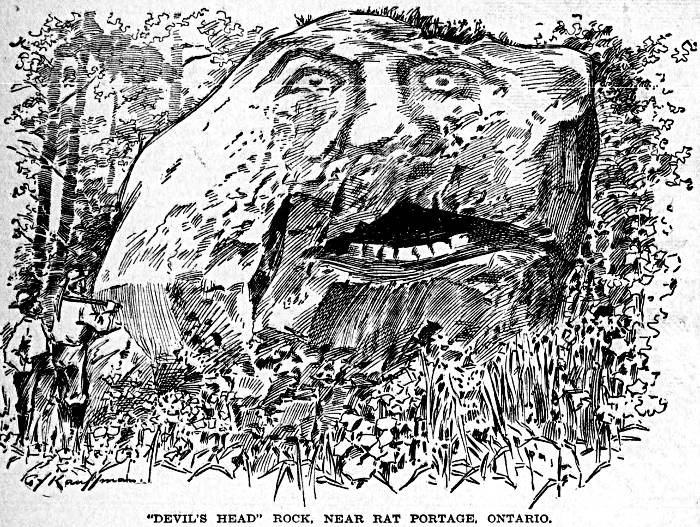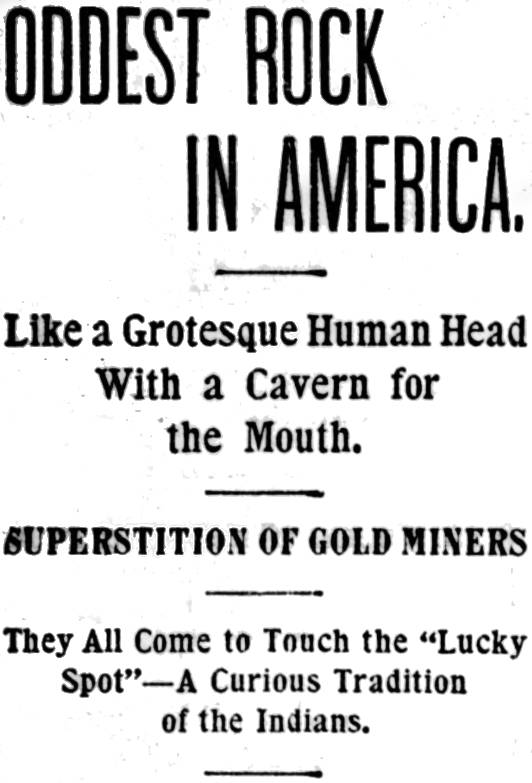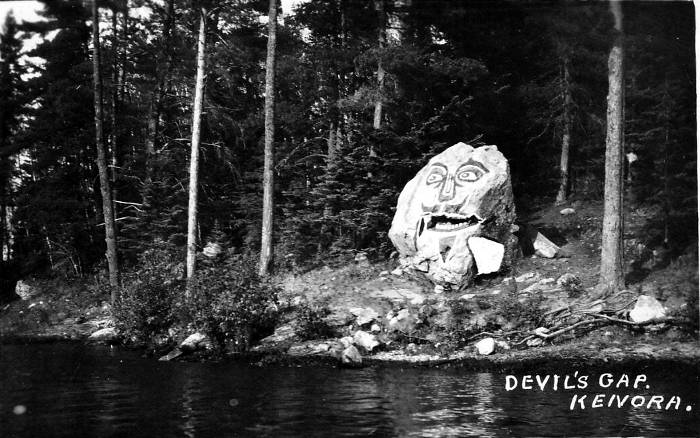West Superior, Wis.. July 20.—On a steep, rocky bluff overhanging a narrow inlet of the Lake of the Woods, about two and one half miles from the mining village of Rat Portage, Ontario, stands one of the most freakish objects to be found anywhere in the world. It consists of a ledge of solid granite which bears a most grotesque resemblance to a human head, its cavernous mouth partly open, its features distorted with a horrible grin. Rude art has supplemented nature in perfecting the resemblance. This monstrosity is commonly known as “Devil’s head,” but is also called “skull rock.” It is about twenty feet high above the bluff, and about twenty-one feet in width at the widest part. Ears, eyes, and a mouth are plainly visible —the latter appearing in the form of a cave, which extends back in the stone about ten feet, and then, like a veritable throat, shoots down a considerable distance into the hill on which it rests.
This extraordinary object has attracted the notice of almost every prospector for precious metal who has visited the region. There is hardly an explorer who has entered the productive gold fields known as the “Rainy and Seine river El Dorado” who has not touched with the palm of his hand a spot just above the eyes in the belief that this act would bring him luck in his search for the precious metal. Perhaps the reason for this singular superstition is the fact that the first gold bearing rock ever found in this region was taken from the mouth of this figure, where it is supposed to have been deposited by the Indians, years ago.
Anyhow, the superstition is prevalent and persistent, and the “lucky spot” has been rubbed so often that It is bald and shiny, and destitute of the mossy growth which clings to the rock elsewhere. It is a sort of “Blarney stone” to the gold seekers.
 A gold miner of thirty years’ experience in the fields of Africa, Australia, and the United States remarked to the writer not long ago that the rock had twice brought him luck, and that once he traveled 1,500 miles to touch it before going out on a six months expedition. “It would have been just as well for me not to have touched the lucky stone, though,” he continued, “for both the fortunes which have come to me through It have faded away, and I am now out for the third time In search of what I have twice squandered with a lavish hand. I am positive that I shall make a strike again, however; the rock will not fall me, and now I shall save what I make out of it.”
A gold miner of thirty years’ experience in the fields of Africa, Australia, and the United States remarked to the writer not long ago that the rock had twice brought him luck, and that once he traveled 1,500 miles to touch it before going out on a six months expedition. “It would have been just as well for me not to have touched the lucky stone, though,” he continued, “for both the fortunes which have come to me through It have faded away, and I am now out for the third time In search of what I have twice squandered with a lavish hand. I am positive that I shall make a strike again, however; the rock will not fall me, and now I shall save what I make out of it.”
How so absurd a belief can be seriously entertained by civilized men is hard to understand, but its existence is not to be denied.
The Indians have a legend concerning the “skull reek” to the effect that it is nothing more nor less than the petrified heart of a great warrior who came from their “happy hunting ground” to protect the tribes of the Northwest against extermination by the whites. They therefore look upon the stone with reverence as a talisman. Yearly delegations from the various tribes visit the spot and deposit food and precious stones in the mouth of their granite giant. It is said by old warriors that every tribe which has heard of the stone possesses a chip broken from it, which Is held most sacred. The Indians also believe that a body, of the same generous proportions as the head, extends down into the earth. The height of
this prehistoric warrior would be some thing like two hundred feet.
In the earlier days a sort of Indian burying ground was established there for the bravest warriors. The custom seems to have been abandoned, however. The stone was used before the country was surveyed to mark certain locations for the Canadian government, and some of the main survey lines which now cut the country into sections were made from this rock as a basic point.
Some one has painted the image with blood red paint, outlining the eyes and nose which appear in the structure of the rock, making them prominent even more than nature left them. This has given the grinning effigy a somewhat funny appearance; certainly it causes in the traveler who beholds it for the first time a very queer sensation, and the boatmen take great delight in frightening the more timid with the unexpected sight as they pass along the river below. Judging, however, from the number of souvenirs taken from the rock every year, it will not long survive the onslaughts of curio hunters.
C. A. MARSHALL.

